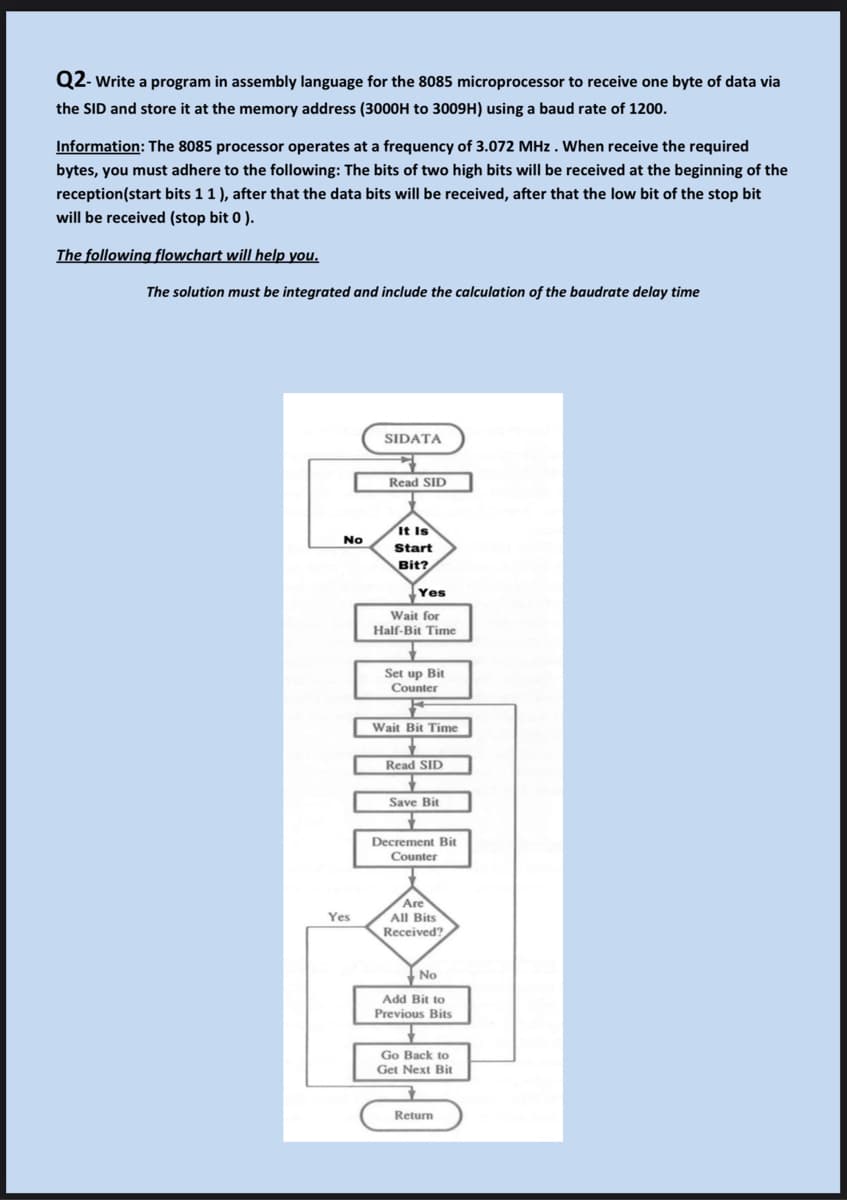Q2- Write a program in assembly language for the 8085 microprocessor to receive one byte of data via the SID and store it at the memory address (3000H to 3009H) using a baud rate of 1200. Information: The 8085 processor operates at a frequency of 3.072 MHz. When receive the required bytes, you must adhere to the following: The bits of two high bits will be received at the beginning of the reception (start bits 1 1), after that the data bits will be received, after that the low bit of the stop bit will be received (stop bit 0). The following flowchart will help you. The solution must be integrated and include the calculation of the baudrate delay time Ol+4[!!!D✨[[0 No Yes SIDATA Read SID Start Bit? Wait for Half-Bit Time Set up Bit Counter Wait Bit Time Read SID Save Bit Decrement Bit Counter All Bits Received? Add Bit to Previous Bits Go Back to Get Next Bit Return
Q2- Write a program in assembly language for the 8085 microprocessor to receive one byte of data via the SID and store it at the memory address (3000H to 3009H) using a baud rate of 1200. Information: The 8085 processor operates at a frequency of 3.072 MHz. When receive the required bytes, you must adhere to the following: The bits of two high bits will be received at the beginning of the reception (start bits 1 1), after that the data bits will be received, after that the low bit of the stop bit will be received (stop bit 0). The following flowchart will help you. The solution must be integrated and include the calculation of the baudrate delay time Ol+4[!!!D✨[[0 No Yes SIDATA Read SID Start Bit? Wait for Half-Bit Time Set up Bit Counter Wait Bit Time Read SID Save Bit Decrement Bit Counter All Bits Received? Add Bit to Previous Bits Go Back to Get Next Bit Return
Chapter11: Operating Systems
Section: Chapter Questions
Problem 30VE
Related questions
Question
Q2- Write a program in assembly language for the 8085 microprocessor to receive one byte of data via the SID and store it at the memory address (3000H to 3009H) using a baud rate of 1200.
Information: The 8085 processor operates at a frequency of 3.072 MHz . When receive the required bytes, you must adhere to the following: The bits of two high bits will be received at the beginning of the reception(start bits 1 1 ), after that the data bits will be received, after that the low bit of the stop bit will be received (stop bit 0 ).
The following flowchart will help you.
The solution must be integrated and include the calculation of the baudrate delay time

Transcribed Image Text:Q2- Write a program in assembly language for the 8085 microprocessor to receive one byte of data via
the SID and store it at the memory address (3000H to 3009H) using a baud rate of 1200.
Information: The 8085 processor operates at a frequency of 3.072 MHz. When receive the required
bytes, you must adhere to the following: The bits of two high bits will be received at the beginning of the
reception (start bits 1 1), after that the data bits will be received, after that the low bit of the stop bit
will be received (stop bit 0).
The following flowchart will help you.
The solution must be integrated and include the calculation of the baudrate delay time
0}+CDI!ID+C60
No
Yes
SIDATA
Read SID
It Is
Start
Bit?
Yes
Wait for
Half-Bit Time
Set up Bit
Counter
F
Wait Bit Time
Read SID
Save Bit
Decrement Bit
Counter
Are
All Bits
Received?
No
Add Bit to
Previous Bits
Go Back to
Get Next Bit
Return
Expert Solution
This question has been solved!
Explore an expertly crafted, step-by-step solution for a thorough understanding of key concepts.
This is a popular solution!
Trending now
This is a popular solution!
Step by step
Solved in 4 steps

Knowledge Booster
Learn more about
Need a deep-dive on the concept behind this application? Look no further. Learn more about this topic, computer-science and related others by exploring similar questions and additional content below.Recommended textbooks for you

Systems Architecture
Computer Science
ISBN:
9781305080195
Author:
Stephen D. Burd
Publisher:
Cengage Learning

Systems Architecture
Computer Science
ISBN:
9781305080195
Author:
Stephen D. Burd
Publisher:
Cengage Learning